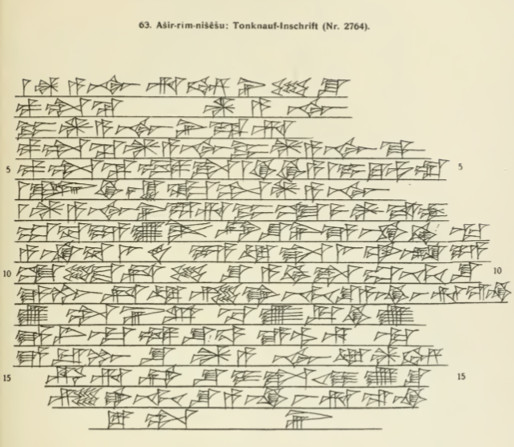Aššur-rêm-nišēšu
The Assyrian King List [/riao/KingLists/AssyrianKingList/AssyrianKingList/index.html#AssurRabi] records that Aššur-rêm-nišēšu was the son of Aššur-bēl-nišēšu and that his reign lasted eight years. However, according to one of his own inscriptions (see below), Aššur-rêm-nišēšu was the son of Aššur-nārārī II. Therefore, he was the brother, not the son, of Aššur-bēl-nišēšu.
Bibliography
Browse the RIA 1 Corpus [/riao/ria1/pager/]
1 1001 1002 1003 1004 1005 1006
1

KAH 1 no. 63
An inscription of Aššur-rêm-nišēšu recording his renovation of the wall of the Inner City of Aššur is known from a clay cone now in the Eski Șark Eserleri Müzesi of the Arkeoloji Müzeleri (Istanbul). This seventeen-line text is an invaluable source of information since it records the early history of that city wall. The Old Assyrian rulers Kikkiya, Ikūnum, Sargon I, Puzur-Aššur II, and Aššur-nārārī I are named as previous builders.
Access the composite text [/riao/ria1/Q005708/] of Aššur-rêm-nišēšu 1.
Bibliography
1001
Parts of the building report and concluding formulae of an inscription of a king around the time of Aššur-rêm-nišēšu are known from a fragment of a clay cone discovered at Aššur. Because the object is a clay cone and since the name of the god Aššur is written as a-šùr, the object is presumed to have been made in the period from Šamšī-Adad III to Aššur-uballiṭ I. The piece is now in the Eski Șark Eserleri Müzesi of the Arkeoloji Müzeleri (Istanbul).
Access the composite text [/riao/ria1/Q005709/] of Aššur-rêm-nišēšu 1001.
Bibliography
1002
A clay cone fragment discovered at Aššur and now in Istanbul (Eski Șark Eserleri Müzesi of the Arkeoloji Müzeleri) preserves parts of the last nine lines of an inscription written by an Assyrian ruler from the period between Šamšī-Adad III and Aššur-uballiṭ I. The name of the structure whose renovation this text commemorates is not preserved.
Access the composite text [/riao/ria1/Q005710/] of Aššur-rêm-nišēšu 1002.
Bibliography
1003
A tiny fragment of a clay cone now in the Vorderasiatisches Museum (Berlin) is inscribed with a text of an unknown ruler, possibly Aššur-rêm-nišēšu. Because the extant text is too minuscule to edit, an edition was not included in Grayson, RIMA 2 (p. 103).
Bibliography
1004
Another small fragment of a clay cone from Aššur has an Assyrian inscription written on it. The object, which is currently in Berlin (Vorderasiatisches Museum), likely dates to sometime between the reign of Šamšī-Adad III and that of Aššur-uballiṭ I. Too little is preserved to warrant an edition.
Bibliography
1005
A minuscule clay cone fragment from Aššur currently in Istanbul (Eski Șark Eserleri Müzesi of the Arkeoloji Müzeleri) preserves a small portion of an inscription of an Assyrian ruler. The text, which was probably written in the period from Šamšī-Adad III to Aššur-uballiṭ I, is too tiny to warrant an edition.
Bibliography
1006
A clay cone fragment from the period between Šamšī-Adad III and Aššur-uballiṭ I preserves the last three lines of an Assyrian inscription. The object is housed in the Eski Șark Eserleri Müzesi of the Arkeoloji Müzeleri (Istanbul).
Access the composite text [/riao/ria1/Q005712/] of Aššur-rêm-nišēšu 1006.
Bibliography
Jamie Novotny & Yehonatan Hershkovitz
Jamie Novotny & Yehonatan Hershkovitz, 'Aššur-rêm-nišēšu', RIA 1: Inscriptions from the Origins of Assyria to Arik-dīn-ili, The RIA Project, 2024 [http://oracc.org/OldAssyrianPeriod/Mittanianhegemony/Ashur-rem-nisheshu/]